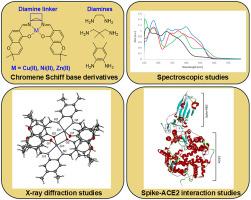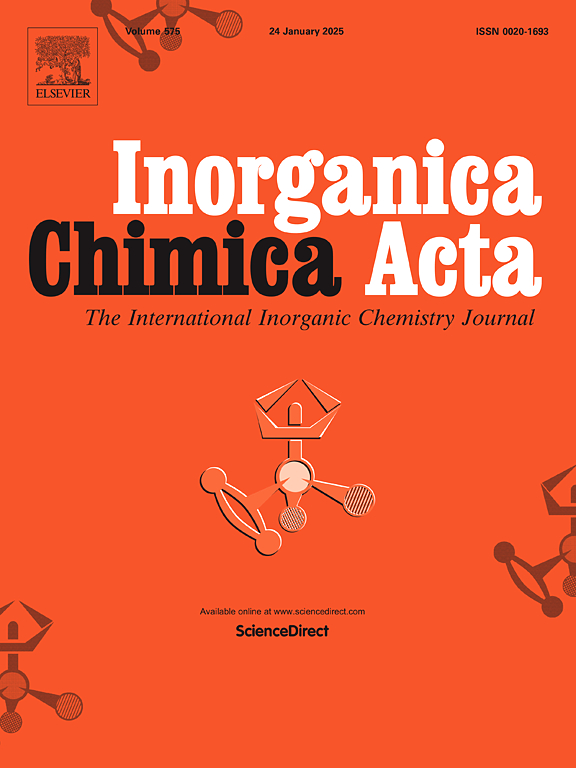Chromene-based Ni(II), Cu(II) and Zn(II) Schiff base complexes: Synthesis, X-ray diffraction, spectroscopic analyses and evaluation of SARS-CoV-2 entry inhibition by molecular docking
IF 3.2
3区 化学
Q2 CHEMISTRY, INORGANIC & NUCLEAR
引用次数: 0
Abstract
Three salen-type chromene Schiff base ligands were synthesized by condensation of 5-hydroxy-2,2-dimethyl-2H-chromene-6-carbaldehyde with ethylenediamine, 2,2-dimethylpropanediamine, and 4,5-dimethyl-1,2-phenylenediamine, and their corresponding mononuclear Cu(II) complexes were prepared. Mononuclear Ni(II) and dinuclear Zn(II) complexes were also prepared for the ligand derived from dimethylphenylenediamine. The ligands and metal complexes were characterized by mass spectrometry and UV–Vis, IR and/or NMR spectroscopy. Further characterization of the metal complexes by single-crystal X-ray diffraction analysis revealed that the rigidity of the diamine linker influenced the coordination geometry of the ligands to the metal ion center. The Cu(II) and Ni(II) complexes adopted a four-coordinate, slightly distorted square planar geometry, while the Zn(II) complex adopted a five-coordinate, slightly distorted square pyramidal geometry. Molecular docking analysis of the ligands and metal complexes with the SARS-CoV-2 spike protein in complex with the ACE2 enzyme (PDB ID: 6M0J) was used to determine the potential of the compounds to function as SARS-CoV-2 viral entry inhibitors. The compounds displayed strong docking affinity (−8.1 to −10.4 kcal/mol) for the spike RBD-ACE2 complex, which was better than that observed for Remdesivir (−7.7 kcal/mol), and showed interaction with key residues involved in stabilizing the complex. These findings indicate that these salen-type chromene Schiff bases and metal complexes may potentially act as SARS-CoV-2 viral entry inhibitors.

铬基Ni(II)、Cu(II)和Zn(II)希夫碱配合物:分子对接抑制SARS-CoV-2进入的合成、x射线衍射、光谱分析和评价
采用5-羟基-2,2-二甲基-2 -h -铬-6-乙醛与乙二胺、2,2-二甲基丙二胺和4,5-二甲基-1,2-苯二胺缩合的方法合成了3种salen型铬希夫碱配体,并制备了相应的单核Cu(II)配合物。二甲基苯二胺衍生的配体还制备了单核Ni(II)和双核Zn(II)配合物。通过质谱、紫外可见光谱、红外光谱和核磁共振光谱对配体和金属配合物进行了表征。通过单晶x射线衍射分析进一步表征金属配合物,发现二胺连接体的刚性影响了配体与金属离子中心的配位几何。Cu(II)和Ni(II)配合物采用四坐标、轻微畸变的方形平面几何,Zn(II)配合物采用五坐标、轻微畸变的方形金字塔几何。利用配体和金属配合物与SARS-CoV-2刺突蛋白与ACE2酶(PDB ID: 6M0J)复合物的分子对接分析,确定这些化合物作为SARS-CoV-2病毒进入抑制剂的潜力。这些化合物对RBD-ACE2络合物具有很强的对接亲和力(−8.1 ~−10.4 kcal/mol),优于对Remdesivir的对接亲和力(−7.7 kcal/mol),并与参与稳定络合物的关键残基相互作用。这些发现表明,这些萨伦型铬希夫碱和金属配合物可能潜在地发挥SARS-CoV-2病毒进入抑制剂的作用。
本文章由计算机程序翻译,如有差异,请以英文原文为准。
求助全文
约1分钟内获得全文
求助全文
来源期刊

Inorganica Chimica Acta
化学-无机化学与核化学
CiteScore
6.00
自引率
3.60%
发文量
440
审稿时长
35 days
期刊介绍:
Inorganica Chimica Acta is an established international forum for all aspects of advanced Inorganic Chemistry. Original papers of high scientific level and interest are published in the form of Articles and Reviews.
Topics covered include:
• chemistry of the main group elements and the d- and f-block metals, including the synthesis, characterization and reactivity of coordination, organometallic, biomimetic, supramolecular coordination compounds, including associated computational studies;
• synthesis, physico-chemical properties, applications of molecule-based nano-scaled clusters and nanomaterials designed using the principles of coordination chemistry, as well as coordination polymers (CPs), metal-organic frameworks (MOFs), metal-organic polyhedra (MPOs);
• reaction mechanisms and physico-chemical investigations computational studies of metalloenzymes and their models;
• applications of inorganic compounds, metallodrugs and molecule-based materials.
Papers composed primarily of structural reports will typically not be considered for publication.
 求助内容:
求助内容: 应助结果提醒方式:
应助结果提醒方式:


